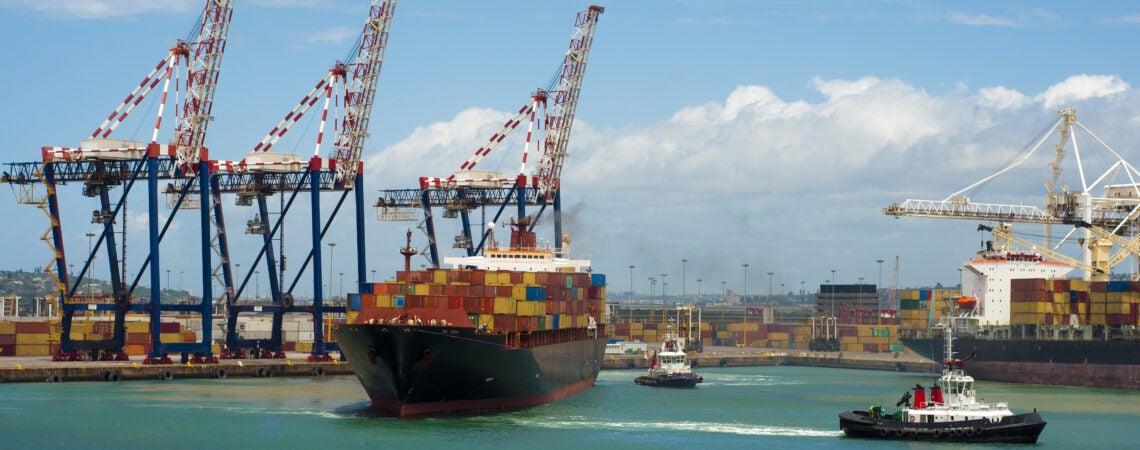Allies for more than a century, now jointly facing Russian and Chinese threats, the U.S. and U.K. are nevertheless squabbling over the steel trade. Resolution will likely lead the U.S. further down the troublesome path of managed trade.
The dispute started in 2018 when President Donald Trump and his obliging secretary of commerce, Wilbur Ross, invoked Section 232 of the Trade Act of 1963, to issue an amazing finding: Steel and aluminum imports not only from NATO allies, but also from Asian allies Japan and Korea, threatened U.S. national security. In March 2018, to redress the imagined threat, Trump slapped a 25% import tariff on steel and a 10% tariff on aluminum. Since steel and aluminum are easily stockpiled, since U.S. military needs are in any event supplied from domestic mills, and since the Pentagon saw no need for protection, national security tariffs made no sense then or now.
But Section 232 offered a lifeline to President Trump and his protectionist acolyte, U.S. Trade Representative Robert Lighthizer. U.S. courts predictably defer to presidents who murmur “national security,” while World Trade Organization rules contain a national security exception. Since legal relief was not to be found, the European Union imposed retaliatory tariffs on $3 billion of iconic U.S. exports, including Harley Davidson motorcycles and Kentucky bourbon, and scheduled another $4 billion of tariff coverage to take effect at the end of 2021 in the absence of a deal. As the U.K. was then a EU member, it was hit by the Section 232 tariffs and fully participated in EU retaliation.
Candidate Joe Biden opposed nearly everything President Trump supported, but he took a shine to trade protection. Progressive Democrats, led by Sens. Sanders and Warren, Alexandria Ocasio-Cortez’s congressional “squad,” and AFL-CIO allies, view free trade as the handiwork of Wall Street and the Chamber of Commerce. Despite abundant evidence, progressives see no benefit from international commerce to American households or workers. President Biden was not about to incur progressive wrath by repealing steel tariffs when he took office. Even though steel prices soared, it was not until October 2021 that Biden crafted a complex deal with the EU to replace steel and aluminum tariffs with so-called tariff-rate quotas specific to individual member countries. With their initial complexity and subsequent tinkering, TRQs are the mother of managed trade. Government officials, not market forces, determine outcomes, invariably accompanied by inefficiency and often corruption.
U.S.-EU TRQs will limit the volume of U.S. imports to pre-2018 levels, but on that volume the U.S. collects no tariffs. Instead, EU steel exporters gain duty-free access for exports of 4.4 million metric tons to the U.S. market (which totals about 100 million tons), where some prices fetch 70% above EU levels. Because the TRQs confine U.S. imports to historic levels, they do nothing to lower inflated prices. A sweet deal for European producers, but no relief for American consumers or U.S. firms that use steel in thousands of products, from buildings and bridges to bicycles and bumpers. In fact, the TRQ deal saps the ability of U.S. steel-using firms to compete in global markets.
One of the many penalties the U.K. incurred when it left the EU was relief from U.S. steel tariffs through the EU deal. Before the Trump tariffs, the U.K. exported around 0.4 million metric tons of steel to the U.S. and very little aluminum. British steel producers understandably want duty-free access to the U.S. market on the sweetheart terms now enjoyed by their European competitors. Biden appears well-disposed to managed trade because of its short-term diplomatic payoff and its appeal to protected U.S. firms. He is probably willing to do a TRQ deal that does not increase the volume of U.S. steel imports. Alas, the Irish question has intruded on trans-Atlantic harmony.
British officials earnestly proclaim that steel talks are entirely separate from Northern Ireland, but key congressional members beg to differ. They fear that Prime Minister Boris Johnson may blow up the EU-U.K. accord that essentially keeps Northern Ireland within EU customs territory, thereby averting a contentious land border with the Irish Republic but dividing the United Kingdom into two economic zones. This standoff precludes a steel deal until the U.K. and the EU finally conclude their divorce agreement and settle Northern Ireland’s status. When that happens, at U.S.-U.K. TRQ seems almost inevitable, another stitch in the fabric of managed trade.
By mid-2019, South Korea, Brazil, Argentina, Canada, and Mexico had reached steel and aluminum quota agreements with Lighthizer, establishing the foundations of managed trade. Now that the U.S.-EU deal has been reached, and a U.S.-U.K. deal is in the air, other countries will predictably join. Even China may sign up. The system of managed steel trade created by Trump and Biden echoes the system of managed textile trade launched by Eisenhower and Kennedy in the late 1950s and early 1960s. That monstrosity grew over the next four decades, at enormous cost to consumers, but ensuring full employment for trade officials. Global commerce in steel and aluminum now travels the same ill-fated path.
Gary Clyde Hufbauer is a senior fellow at the Peterson Institute for International Economics
To read the full commentary by Barron’s, please click here.

